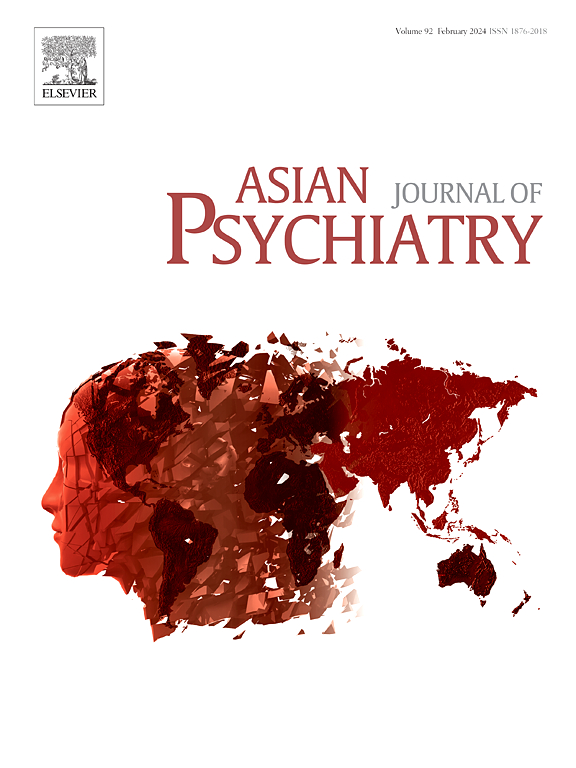致幻剂致精神病的治疗方法和疗效:系统综述
IF 4.5
4区 医学
Q1 PSYCHIATRY
引用次数: 0
摘要
致幻剂在普通人群中的使用越来越多,但在少数使用者中,它们与精神病的风险增加有关,这些使用者可以经历致幻剂引起的精神病(在对照试验环境中为1 %)。相比之下,关于治疗迷幻药引起的精神病的证据至今仍然很少。我们进行了一项符合PRISMA 2020标准的系统评价(CRD42023399591),检索电子数据库(开始- 2024年8月),以获取有关迷幻药诱导精神病治疗的介入性、观察性研究、病例系列或病例报告。分析人群频率、治疗和结局特征。我们纳入了14个病例系列,20个病例报告和一项前瞻性研究,报告了1955年至2024年间93例致幻剂引起的精神病。主要涉及的物质为LSD(47.3% %)和MDMA(38.7 %),患者平均年龄为23.7 ± 6.3岁,男性居多(88 %)。精神病持续时间平均为1.8周。我们确定了两种主要的治疗类别:第一代抗精神病药物(n = 37)和第二代抗精神病药物(n = 57)。电惊厥治疗用于少数病例(n = 9)。第一代抗精神病药物的有效率(27 %)明显低于第二代药物(91.3 %)和电休克治疗(91 %)。随访数据显示,34% %的患者后来发展为精神分裂症谱系障碍,20.4% %的患者被诊断为双相情感障碍。然而,缺乏全面的随访限制了对研究结果的解释。总之,支持治疗方案的证据仍然有限,主要基于病例报告。我们的研究结果表明,第二代抗精神病药物似乎在治疗致幻剂引起的精神病方面更有益,值得进一步研究优化的治疗方案。本文章由计算机程序翻译,如有差异,请以英文原文为准。
Treatment approaches and efficacy in psychedelic-induced psychosis: A systematic review
Psychedelics are increasingly used in the general population, yet they are associated with increased risk of psychosis in a minority of users that can experience psychedelic-induced psychosis (<1 % in controlled trial settings). In contrast, the evidence regarding the treatment of psychedelics-induced psychosis remains to date scarce. We conducted a PRISMA 2020-compliant systematic review (CRD42023399591), searching electronic databases (inception–August 2024) for interventional, observational studies, case series, or case reports on the treatment of psychedelic-induced psychosis. Frequencies of population, treatment, and outcome characteristics were analyzed. We included 14 case series, 20 case reports, and one prospective study, reporting on 93 cases of psychedelic-induced psychosis, between 1955 and 2024. The primary substances implicated were LSD (47.3 %) and MDMA (38.7 %), and the average patient age of 23.7 ± 6.3 years, with a predominance of male subjects (88 %). Psychosis lasted an average of 1.8 weeks. We identified two main treatment categories: first-generation antipsychotics (n = 37) and second-generation antipsychotics (n = 57). Electroconvulsive therapy was used in a minor subset of cases (n = 9). The response rate for first-generation antipsychotics (27 %) was significantly lower than that for second-generation agents (91.3 %) and electroconvulsive therapy (91 %). Follow-up data indicated 34 % of patients later developed schizophrenia spectrum disorders, and 20.4 % were diagnosed with bipolar disorder. However, the lack of comprehensive follow-up limits the interpretation of findings In conclusion, the evidence supporting treatment options remains limited, primarily based on case reports. Our findings suggest that second-generation antipsychotics seem to be more beneficial in managing psychedelic-induced psychosis, warranting further investigation into optimized treatment protocols.
求助全文
通过发布文献求助,成功后即可免费获取论文全文。
去求助
来源期刊

Asian journal of psychiatry
Medicine-Psychiatry and Mental Health
CiteScore
12.70
自引率
5.30%
发文量
297
审稿时长
35 days
期刊介绍:
The Asian Journal of Psychiatry serves as a comprehensive resource for psychiatrists, mental health clinicians, neurologists, physicians, mental health students, and policymakers. Its goal is to facilitate the exchange of research findings and clinical practices between Asia and the global community. The journal focuses on psychiatric research relevant to Asia, covering preclinical, clinical, service system, and policy development topics. It also highlights the socio-cultural diversity of the region in relation to mental health.
 求助内容:
求助内容: 应助结果提醒方式:
应助结果提醒方式:


